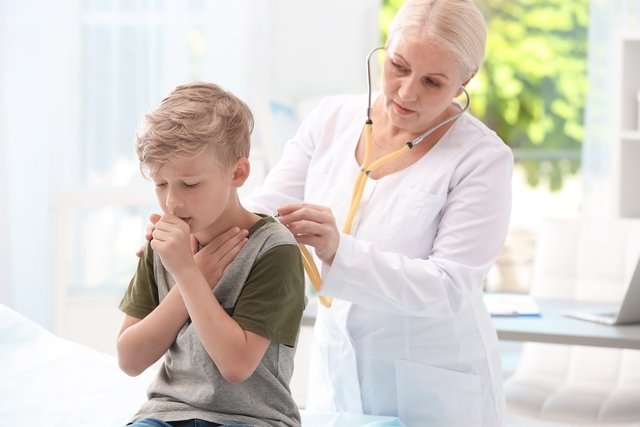The symptoms of bronchitis are a persistent or constant cough, with phlegm but which can also be dry, difficulty breathing, wheezing, a feeling of tightness in the chest, low-grade fever or general malaise.
These symptoms arise due to inflammation of the bronchi in the lungs caused by flu, colds or allergies, resulting in greater phlegm production, which reduces airflow in the lungs, making breathing difficult. Check out the main causes of bronchitis.
In the presence of symptoms of bronchitis, you should consult a pulmonologist, general practitioner or pediatrician to confirm the diagnosis and initiate the most appropriate treatment.

12 symptoms of bronchitis
The main symptoms of bronchitis are:
- Cough with phlegm or dry cough;
- Transparent, yellowish, green or bloody phlegm, in some cases;
- Difficulty breathing;
- Shortness of breath that worsens during light activities or physical exertion;
- Wheezing in the chest when breathing;
- Discomfort, pain or feeling of tightness in the chest;
- Runny or stuffy nose;
- Sore throat;
- Low fever;
- Excessive tiredness;
- General malaise;
- Chills, in some cases.
These symptoms can appear in both acute and chronic bronchitis, and Persistent coughing is the most common, lasting 10 to 20 days in acute bronchitis and 3 months or more in chronic bronchitis..
It is important to consult a pulmonologist if symptoms of bronchitis appear so that the most appropriate treatment can be diagnosed and started.
Bronchitis Symptoms Online Test
If you think you may have bronchitis, select the symptoms you have in the test below to find out your risk:
The symptom test is only a guidance tool and does not serve as a diagnosis and does not replace consultation with a pulmonologist or general practitioner.
Symptoms of a bronchitis attack
Symptoms of a bronchitis attack are coughing, shortness of breath, wheezing, excessive tiredness, chest pain or low fever. In some cases, chills may also appear.
Bronchitis attacks can arise due to acute bronchitis or exacerbations of chronic bronchitis, and it is important to consult a doctor immediately or go to the nearest emergency room, especially if the symptoms are intense. Understand what chronic bronchitis is and the main symptoms.
Symptoms of bronchitis in babies
The main symptom of bronchitis in babies and children is a persistent or constant cough, which may or may not have phlegm.
In addition, the baby may also have a runny nose, refusal to eat, difficulty breathing, weakness, vomiting, irritability or fever, in some cases.
These symptoms may vary according to the cause of bronchitis and the severity of the disease, and it is recommended that you consult your pediatrician to begin the most appropriate treatment. Know how to identify all the symptoms of bronchitis in babies.
Symptoms of asthmatic bronchitis
The symptoms of asthmatic bronchitis, also called asthma, are difficulty breathing and the feeling that air is not reaching the lungs, persistent coughing or wheezing when breathing, which can be more intense in cases of attacks. See other symptoms of asthmatic bronchitis.
Asthmatic bronchitis can be caused by allergies to dust, mold, pollen, plants, animal hair, respiratory infections or smoking, for example, and it is important to go to the emergency room whenever symptoms of an asthmatic bronchitis attack appear.
How to confirm if it is bronchitis
To confirm bronchitis, it is recommended to make an appointment with a pulmonologist, general practitioner or pediatrician, for an assessment of symptoms and auscultation of the lungs in order to identify any changes in breathing.
Make an appointment with a pulmonologist in the nearest region:
Taking care of your health has never been easier!
Generally, no additional tests are needed when vital signs are normal.
However, in the case of the elderly or when the doctor suspects pneumonia, whooping cough or chronic bronchitis, for example, tests may be requested, such as a chest X-ray, blood test or sputum test. See how the sputum test is done.
When to make an appointment
It is important to make an appointment with a pulmonologist or pediatrician whenever symptoms of bronchitis appear in babies, children or the elderly.
In addition, also consult a doctor in cases of cough that does not improve within 2 weeks, wheezing, shortness of breath, cough with blood or mucus or fever with a temperature greater than or equal to 38ºC. See other causes of bloody phlegm.
What causes bronchitis symptoms?
Bronchitis can be caused by viral infections, such as flu or colds, smoking, being in environments that have a lot of smoke or dust, or allergies to pollen or perfume, for example.
Although less common, bronchitis can also be caused by bacteria such as Streptococcus pneumonia or Staphylococcus aureus.
How the treatment is carried out
The treatment of bronchitis is carried out by a pulmonologist, general practitioner or pediatrician, and normally involves the use of medicines to relieve coughing and increase expectoration.
Thus, the use of acebrophylline, acetylcysteine or ambroxol syrups, for example, may be recommended by the doctor. In addition, bronchodilators, corticosteroids or antibiotics may also be indicated. Check out all the syrups and remedies for bronchitis.
Home treatment for bronchitis
Home treatment for bronchitis can be done with a diet rich in fruits, vegetables and nuts, as they help to strengthen the immune system, reducing the duration and preventing bronchitis attacks. See how to follow a bronchitis diet.
Furthermore, some teas, such as anise tea, mallow tea or garlic tea, can be used as a home remedy as they help to eliminate phlegm more easily, relieving coughs. Learn how to prepare home remedies for bronchitis.
Home treatments can be used to complement medical treatment, and do not replace medicines and care recommended by a doctor.

Sign up for our newsletter and stay up to date with exclusive news
that can transform your routine!
Warning: Undefined array key "title" in /home/storelat/public_html/wp-content/plugins/link-whisper-premium/templates/frontend/related-posts.php on line 12
Warning: Undefined array key "title_tag" in /home/storelat/public_html/wp-content/plugins/link-whisper-premium/templates/frontend/related-posts.php on line 13



